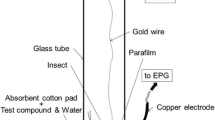Abstract
An automated device was used to examine, in detail, feeding on disks of wheat germ medium by fifth-instar Manduca sextacaterpillars. Comparisons were made between some animals which had ad libitum access to food at all times and others which were deprived of food for 1–5 h before being tested. Feeding patterns of both groups indicated regulation of feeding both between and within meals. Deprived animals ate more during their first meal than did nondeprived animals chiefly by increasing (a) the number of chewing bouts (and thus the meal duration) and (b) the bite frequency. Calculations indicated that the deficit caused by deprivation was made up during the first meal. However, deprived animals continued to eat more than nondeprived ones in subsequent feeding also. Passage of food through the gut was examined by dissecting out the contents of each region of the gut at various times after a colored test meal. Food passed through the foregut directly into the anterior part of the midgut. It stayed in the middle third of the midgut longer than in the anterior and posterior thirds, and the first pellet resulting from the test meal appeared 4 h after the meal. The following mechanisms of feeding regulation are proposed: (a) volumetric feedback mediated by stretch receptors of the foregut and anterior third of the midgut which terminates meals; (b) the development and subsequent reduction of satietyspecific behaviors mediated either by stretch receptors or by some other means which, e.g., allow the next meal to begin; and (c) metabolites whose levels drop during deprivation, triggering a series of events which lead to the excess feeding observed.
Similar content being viewed by others
References
Baumhover, A. H., Cantelo, W. W., Hobgood, J. M., Jr., Knott, C. M., and Lam, J. J. (1977). An improved method for mass rearing the tobacco hornworm. Agricultural Research Service, U.S. Dept. Agr. ARS-S-167.
Bernays, E. A. (1980). The post-prandial rest inLocusta migmtoria nymphs and its hormonal regulation.J. Insect Physiol. 26: 119–123.
Bernays, E. A., and Chapman, R. F. (1972a). Meal size in nymphs ofLocusta migratoria.Entomol. Exp. Appl. 15: 339–410.
Bernays, E. A., and Chapman, R. F. (1972b). The control of changes in peripheral sensilla associated with feeding inLocusta migratoria (L.).J. Exp. Biol. 57: 755–763.
Bernays, E. A., and Chapman, R. F. (1974). The regulation of food intake by Acridids. In Barton Browne, L. (ed.),Experimental Analysis of Insect Behaviour, Springer-Verlag, New York, Heidelberg, Berlin, pp. 48–59.
Bernays, E. A., and Mordue (Luntz), A. J. (1973). Changes in palp tip sensilla ofLocusta migratoria in relation to feeding: The effects of different levels of hormone.Comp. Biochem. Physiol. 45A: 451–454.
Bernays, E. A., Blaney, W. M., and Chapman, R. F. (1972). Changes in chemoreceptor sensilla on the maxillary palps ofLocusta migratoria in relation to feeding.J. Exp. Biol. 57: 745–753.
Borer, K. T., Rowland, N., Mirow, A., Borer, R. C., Jr., and Kelch, R. P. (1979). Physiological and behavioral responses to starvation in the golden hamster.Am. J. Physiol.,236: E105-E112.
Bowdan, E. (1984). An apparatus for the continuous monitoring of feeding by caterpillars in choice or non-choice tests (automated cafeteria test).Entomol. Exp. Appl. 36: 13–16.
Bowdan, E. (1987). Microstructure of feeding by tobacco hornworm caterpillars,Manduca sexta. Entomol. Exp. Appl. (in press).
Bowdan, E., and Dethier, V. G. (1986). Coordination of a dual inhibitory system regulating feeding behaviour in the blowfly.J. Comp. Physiol. 158: 713–722.
Dorfman, K. A. (1982).Feeding Behavior in Manduca sexta: The Roles of Nutrition and Experience, Ph.D. dissertation, University of Massachusetts, Amherst.
Engelmann, F. (1968). Feeding and crop emptying in the cockroachLeucophaea maderae.J. Insect Physiol. 14: 1525–1531.
Engelmann, F. (1969). Food-stimulated synthesis of intestinal proteolytic enzymes in the cockroachLeucophaea maderae.J. Insect Physiol. 15: 217–235.
Evans, D. R., and Dethier, V. G. (1957). The regulation of taste thresholds for sugars in the blowfly.J. Insect Physiol. 1: 3–17.
Gelperin, A. (1971). Abdominal sensory neurons providing negative feedback to the feeding behavior of the blowfly.Z. Vergl. Physiol. 72: 17–31.
Green, G. W. (1964a). The control of spontaneous locomotor activity inPhormia regina Meigen. I. Locomotor activity patterns of intact flies.J. Insect Physiol. 10: 711–726.
Green, G. W. (1964b). The control of spontaneous locomotor activity inPhormia regina Meigen. II. Experiments to determine the mechanism used.J. Insect Physiol. 10: 727–752.
Jones, D., Jones, G., and Bhaskaran, G. (1981). Dietary sugars, hemolymph trehalose levels, and supernumerary molting ofManduca sexta larvae.Physiol. Zool. 54: 260–266.
Knight, M. R. (1962). Rhythmic activities of the alimentary canal of the black blow fly,Phormia regina (Diptera: Calliphoridae).Ann. Entomol. Soc. 55: 380–382.
Kushner, L. R., and Mook, D. G. (1984). Behavioral correlates of oral and postingestive satiety in the rat.Physiol. Behav. 33: 713–718.
Lövei, G. L., Monostori, E., and Ando, I. (1985). Digestion rate in relation to starvation in the larva of a carabid predator,Poecilus cupreus.Entomol. Exp. Appl. 37: 123–127.
Miller, J. R., and Strickler, K. L. (1984). Finding and accepting host plants. In Bell, W. J., and Carder, R. T. (eds.),Chemical Ecology of Insects, Sinauer Associates, Sunderland, Mass., pp. 127–157.
Peterson, A. (1912). Anatomy of the tomato-worm larva,Protoparce Carolina.Ann. Entomol. Soc. Am. 5: 246–269.
Reynolds, S. E., Yeomans, M. R., and Timmins, W. A. (1986). The feeding behavior of caterpillars (Manduca sexta) on tobacco and an artificial diet.Physiol. Entomol. 11: 39–51.
Roessingh, P., and Simpson, S. J., (1984). Volumetric feedback and the control of meal size inSchistocerca gregaria.Entomol. Exp. Appl. 36: 279–286.
Saito, S. (1963). Trehalose in the body fluid of the silkworm,Bombyx morp, L.J. Insect Physiol. 9: 509–519.
Simpson, S. J. (1982). Patterns in feeding: A behavioural analysis usingLocusta migratoria nymphs.Physiol. Entomol. 7: 325–336.
Yeager, J. F. (1931). Observations on crop and gizzard movements in the cockroach,Periplaneta fulginosa (Serv.).Ann. Entomol. Soc. Am. 24: 739–745.
Author information
Authors and Affiliations
Rights and permissions
About this article
Cite this article
Bowdan, E. The effect of deprivation on the microstructure of feeding by the Tobacco hornworm caterpillar. J Insect Behav 1, 31–50 (1988). https://doi.org/10.1007/BF01052502
Accepted:
Issue Date:
DOI: https://doi.org/10.1007/BF01052502




